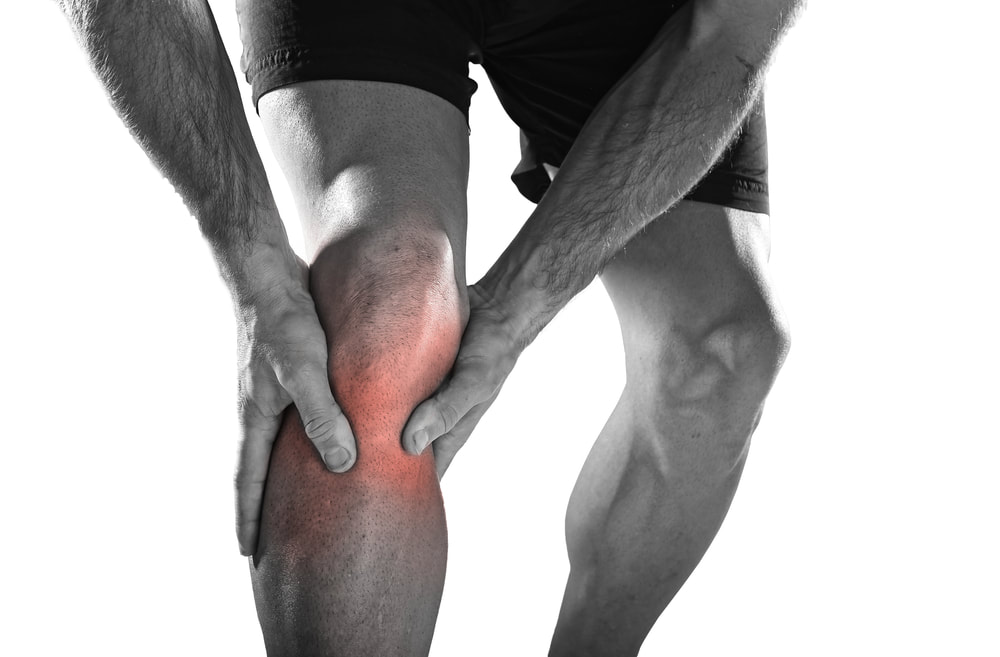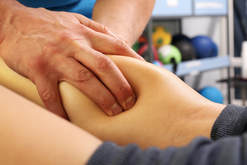"
In 2019 Dubois & Esculier (2020) came up with the acronym of ‘Peace & Love’ for managing new injuries.
Its sounds a bit twee doesn’t it. A proposed scientific model for managing something that just happens to spell a catchy acronym. Looking selectively at only certain pieces of research has meant the catchy acronym can be delivered possibly at the cost of a balanced viewpoint and failing to acknowledging where there is conflicting evidence. Unfortunately the authors were selective in the use of research, narrow in the range of studies used, and biased in the sporting populations that the research evidence came from.….not all sports injuries and pain are running injuries. More on this later.
Here’s what the wider scientific evidence suggests you should consider with a new injury.
Was it an sudden onset actual injury? Did something traumatic happen that you recall or did you just the develop the pain over a more prolonged period of time and sports training?
Caneiro et al. (2021) have highlighted that sudden onset non-traumatic pain in athletes is often NOT a structural injury (trauma) but related to tissue tolerance (chemical pain). Pain can also be due to mechanical dysfunction which is often associated with tissue tolerance pain. This should be remembered. Repetitive micro-trauma can lead to tissue-based pain so pain emerges gradually – this has often been termed overuse injury although we tend to drop the ‘injury’ part of this as it implies tissue damage. The high adrenaline levels during training and sport can also mean that it doesn’t feel like much at the time, but if pain and swelling develop over a few days then get it checked out. Lots can be done to help rehabilitate tissue tolerance-based and mechanical (nociceptive) pains also. Additional symptoms, such as feelings of weakness or instability, pins and needles, tingling or numbness should also be checked out if you want to know whether it’s a good idea to keep exercising or not.
The injury was sudden onset. Should I protect it?
The evidence from all soft tissue injury guidelines over the past 30 years agree that protection is important to create stress shielding of fibres in the case of new injuries. Reducing training load, wearing an appropriate brace, support or sports taping for a few days can all assist. Do we always need to ease back every time we experience pain. No not necessarily but only a professional medical or advanced physiotherapy opinion will really answer this for you – there are many different factors and many different reasons and contributors to pain. Certainly if there is a pattern that the problem is not resolving you would benefit from a professional opinion.
Should I elevate a newly injured limb?
There is only weak scientific evidence that this may be helpful in the first 1 to 3 days. You should certainly only consider it if there is significant swelling present and not if there isn’t.
Should I apply compression?
A systematic review by Hansroni et al. (2015) reported no positive effect on functional recovery in ankle sprains and even reported that compressive bandages may be linked to increased analgesia use.
Should I take anti-inflammatories for it or use heat or ice?
Heat for a new injury hasn’t been included in the physiotherapy or medical guidance for a new injury in any of the guidelines produced in the last 30 years. In tissue tolerance scenarios heat can sometimes be indicated due to the benefits of increased blood flow and changes in the chemical environment it can bring. Heat can also help ease off very guarded muscles and help ease nerve pain. There is an underlying question: if there is significant muscle guarding of a body part, why is this? Assessment of significant ongoing or recurrent pain, stiffness or guarding is helpful.
Dubois & Esculier (2020) have advised that anti-inflammatories and ice packs should now be avoided with new injuries. - not everyone agrees. The idea here is that we should allow swelling to happen rather than ‘treat the swelling’. They reference Singh et al’s 2017 study on icing of contusion (direct impact) injuries in rats. This study has several problems: it’s done in rats; only for impact injuries; there were problems with the staining techniques used on their physiological markers; and the study authors state that the changes are not sufficient to affect the muscle regeneration seen at one week post-injury! Other studies using more dynamic physiological markers (this is probably better!) do show benefits of icing. Reducing secondary cell death is not mentioned in Dubois & Esculier’s model but previous studies and guidelines have supported the position that icing reduced secondary cell death.
The scientific jury has been unable to reach a clear verdict on this one yet.
My Clinical Advice:
Protect the body part, perhaps reduce loading to a degree. Try and see if you can make good progress over a few days without any anti-inflammatories or ice packs. If you are not making good progress and it’s interfering with your life or sport, or the problem keeps recurring, then it’s time to get your injury assessed and get some specific professional advice. Symptoms, such as feelings of weakness or instability, pins and needles, tingling or numbness should be checked out by a suitably qualified professional.
A Critical Summary of the P-E-A-C-E regime for what to do in the first few days post-injury:
It’s ‘YES’ to the P (protect) and the E (educate); it’s inconclusive for the E (elevate), A (avoid), and C (compression).
A biased case of trying to create a snappy, headline hitting soundbite perhaps over a rounded evaluation of the research.
Now to the Sub-Acute Phase: What to do from day 3 post-injury onwards?
Should I still be resting the injury?
For soft tissue injuries we should gradually try to increase the load we put through an injury. Exceptions to this include where a joint feels unstable or unsupported, or you are experiencing weakness – my best advice is to get it assessed by a specialist in musculoskeletal injury. If it’s a one-off overtraining or overloading issue pain should naturally ease off quickly over a few days (unless you are in a bad pattern). If it’s a tear it’s likely to become more painful if too much load is put through it and may worsen the injury if done too soon.
Should I just push on through?
There is plenty of research to support us encouraging positivity. Developing fears, worries, and anxiety tend to make the body more sensitive and over-reactive and the person unhelpfully over-protective. However, if a joint ‘doesn’t feel right’ it can also be due to an instability which does place the tissues at risk of more significant injury. Most injuries will improve well so do expect this but if something is not feeling right having a physical examination done will tell you with greater certainty whether there may be anything else going on, putting your mind at ease, and helping you retain a healthy and balanced optimism, not blind faith. Joint stability tests are very useful in well trained hands, and neurological examination can screen for and detect more serious problems that should be considered. A risk with the YouTube world of quick fixes and self-appointed gurus is that problems are not professionally assessed – good luck with that! Also be careful to see the right professional for the right problem. Look for a professional trained in high level assessment and diagnosis. Diagnosis and professional opinion precedes treatment and management planning. If you’re going to fix your own car you will need some training in how to fix it and you’ll need to know what the problem is you are trying to fix.
False optimism is not helpful. Be confident and smart but don’t be a confident fool. Many an injury has been exacerbated, either short or long term by the over-zealous over-loader. Great results come with dedication to progression in training over time. Hard work pays off doesn’t mean its quick or easy.
Rehabilitation needs to be paced and structured just like training does.
It hurts to lift weights, can I do some cardio at the meantime?
After a few days, encouraging blood flow to injured or sensitive tissue if a good idea. Doing some light and pain-free cardio, such as on a bike, rower or other ergometer of some sort is helpful in so much as blood flow helps deliver oxygen and nutrients to tissue. So as long as the load isn’t too high, yes it’s good to move, as long as your body is liking it and no symptoms are getting worse as a result. A light easy run may even be helpful when heavy lifts or high intensity are not feeling happy but pace work and hills are a different issue again. Taking a graded, active approach to recovery is supported by multiple research studies across a range of musculoskeletal conditions and can help physically and psychologically – it’s a general guidance though and doesn’t tell you exactly what you should do for any one specific problem. Movement generally helps healing rather than hinders it but there are 10,001 different injuries and issues that mean one size fits all is not possible and knowing how much of what is most helpful depends on the individual circumstance and the specific presenting problem, so often we come back to the questions ‘what is the actual problem?’ and ‘what’s the best management or treatment for my problem?’. Being specific and accurate about this matters.
A Critical Summary of the L-O-V-E regime for what to do in the sub-acute phase of injury:
It’s ‘YES’ to L (load, graded) – O (optimism, but not false optimism), V (vascularisation, think blood flow without tissue overload), and E (exercise, active rehab is central to your sustained progress). It’s the 'how' that a professional can help you with. It's the specific steps taken within these variables that is the key to excellence in sports medicine.
So, it’s YES to L-O-V-E.
I’m going to close with a summary statement by Bleakey, Glasgow & MacAuley (2011):
“A loading strategy for injured tissue should reflect the unique mechanical stresses placed on the tissue during functional activities, which varies across tissue type and anatomical region. Optimal loading is sport specific. The challenge is in determining the optimal dosage, nature and timing of loading."
Get a specific assessment of your pain problem and then you can have a specific action plan.
In 2019 Dubois & Esculier (2020) came up with the acronym of ‘Peace & Love’ for managing new injuries.
Its sounds a bit twee doesn’t it. A proposed scientific model for managing something that just happens to spell a catchy acronym. Looking selectively at only certain pieces of research has meant the catchy acronym can be delivered possibly at the cost of a balanced viewpoint and failing to acknowledging where there is conflicting evidence. Unfortunately the authors were selective in the use of research, narrow in the range of studies used, and biased in the sporting populations that the research evidence came from.….not all sports injuries and pain are running injuries. More on this later.
Here’s what the wider scientific evidence suggests you should consider with a new injury.
Was it an sudden onset actual injury? Did something traumatic happen that you recall or did you just the develop the pain over a more prolonged period of time and sports training?
Caneiro et al. (2021) have highlighted that sudden onset non-traumatic pain in athletes is often NOT a structural injury (trauma) but related to tissue tolerance (chemical pain). Pain can also be due to mechanical dysfunction which is often associated with tissue tolerance pain. This should be remembered. Repetitive micro-trauma can lead to tissue-based pain so pain emerges gradually – this has often been termed overuse injury although we tend to drop the ‘injury’ part of this as it implies tissue damage. The high adrenaline levels during training and sport can also mean that it doesn’t feel like much at the time, but if pain and swelling develop over a few days then get it checked out. Lots can be done to help rehabilitate tissue tolerance-based and mechanical (nociceptive) pains also. Additional symptoms, such as feelings of weakness or instability, pins and needles, tingling or numbness should also be checked out if you want to know whether it’s a good idea to keep exercising or not.
The injury was sudden onset. Should I protect it?
The evidence from all soft tissue injury guidelines over the past 30 years agree that protection is important to create stress shielding of fibres in the case of new injuries. Reducing training load, wearing an appropriate brace, support or sports taping for a few days can all assist. Do we always need to ease back every time we experience pain. No not necessarily but only a professional medical or advanced physiotherapy opinion will really answer this for you – there are many different factors and many different reasons and contributors to pain. Certainly if there is a pattern that the problem is not resolving you would benefit from a professional opinion.
Should I elevate a newly injured limb?
There is only weak scientific evidence that this may be helpful in the first 1 to 3 days. You should certainly only consider it if there is significant swelling present and not if there isn’t.
Should I apply compression?
A systematic review by Hansroni et al. (2015) reported no positive effect on functional recovery in ankle sprains and even reported that compressive bandages may be linked to increased analgesia use.
Should I take anti-inflammatories for it or use heat or ice?
Heat for a new injury hasn’t been included in the physiotherapy or medical guidance for a new injury in any of the guidelines produced in the last 30 years. In tissue tolerance scenarios heat can sometimes be indicated due to the benefits of increased blood flow and changes in the chemical environment it can bring. Heat can also help ease off very guarded muscles and help ease nerve pain. There is an underlying question: if there is significant muscle guarding of a body part, why is this? Assessment of significant ongoing or recurrent pain, stiffness or guarding is helpful.
Dubois & Esculier (2020) have advised that anti-inflammatories and ice packs should now be avoided with new injuries. - not everyone agrees. The idea here is that we should allow swelling to happen rather than ‘treat the swelling’. They reference Singh et al’s 2017 study on icing of contusion (direct impact) injuries in rats. This study has several problems: it’s done in rats; only for impact injuries; there were problems with the staining techniques used on their physiological markers; and the study authors state that the changes are not sufficient to affect the muscle regeneration seen at one week post-injury! Other studies using more dynamic physiological markers (this is probably better!) do show benefits of icing. Reducing secondary cell death is not mentioned in Dubois & Esculier’s model but previous studies and guidelines have supported the position that icing reduced secondary cell death.
The scientific jury has been unable to reach a clear verdict on this one yet.
My Clinical Advice:
Protect the body part, perhaps reduce loading to a degree. Try and see if you can make good progress over a few days without any anti-inflammatories or ice packs. If you are not making good progress and it’s interfering with your life or sport, or the problem keeps recurring, then it’s time to get your injury assessed and get some specific professional advice. Symptoms, such as feelings of weakness or instability, pins and needles, tingling or numbness should be checked out by a suitably qualified professional.
A Critical Summary of the P-E-A-C-E regime for what to do in the first few days post-injury:
It’s ‘YES’ to the P (protect) and the E (educate); it’s inconclusive for the E (elevate), A (avoid), and C (compression).
A biased case of trying to create a snappy, headline hitting soundbite perhaps over a rounded evaluation of the research.
Now to the Sub-Acute Phase: What to do from day 3 post-injury onwards?
Should I still be resting the injury?
For soft tissue injuries we should gradually try to increase the load we put through an injury. Exceptions to this include where a joint feels unstable or unsupported, or you are experiencing weakness – my best advice is to get it assessed by a specialist in musculoskeletal injury. If it’s a one-off overtraining or overloading issue pain should naturally ease off quickly over a few days (unless you are in a bad pattern). If it’s a tear it’s likely to become more painful if too much load is put through it and may worsen the injury if done too soon.
Should I just push on through?
There is plenty of research to support us encouraging positivity. Developing fears, worries, and anxiety tend to make the body more sensitive and over-reactive and the person unhelpfully over-protective. However, if a joint ‘doesn’t feel right’ it can also be due to an instability which does place the tissues at risk of more significant injury. Most injuries will improve well so do expect this but if something is not feeling right having a physical examination done will tell you with greater certainty whether there may be anything else going on, putting your mind at ease, and helping you retain a healthy and balanced optimism, not blind faith. Joint stability tests are very useful in well trained hands, and neurological examination can screen for and detect more serious problems that should be considered. A risk with the YouTube world of quick fixes and self-appointed gurus is that problems are not professionally assessed – good luck with that! Also be careful to see the right professional for the right problem. Look for a professional trained in high level assessment and diagnosis. Diagnosis and professional opinion precedes treatment and management planning. If you’re going to fix your own car you will need some training in how to fix it and you’ll need to know what the problem is you are trying to fix.
False optimism is not helpful. Be confident and smart but don’t be a confident fool. Many an injury has been exacerbated, either short or long term by the over-zealous over-loader. Great results come with dedication to progression in training over time. Hard work pays off doesn’t mean its quick or easy.
Rehabilitation needs to be paced and structured just like training does.
It hurts to lift weights, can I do some cardio at the meantime?
After a few days, encouraging blood flow to injured or sensitive tissue if a good idea. Doing some light and pain-free cardio, such as on a bike, rower or other ergometer of some sort is helpful in so much as blood flow helps deliver oxygen and nutrients to tissue. So as long as the load isn’t too high, yes it’s good to move, as long as your body is liking it and no symptoms are getting worse as a result. A light easy run may even be helpful when heavy lifts or high intensity are not feeling happy but pace work and hills are a different issue again. Taking a graded, active approach to recovery is supported by multiple research studies across a range of musculoskeletal conditions and can help physically and psychologically – it’s a general guidance though and doesn’t tell you exactly what you should do for any one specific problem. Movement generally helps healing rather than hinders it but there are 10,001 different injuries and issues that mean one size fits all is not possible and knowing how much of what is most helpful depends on the individual circumstance and the specific presenting problem, so often we come back to the questions ‘what is the actual problem?’ and ‘what’s the best management or treatment for my problem?’. Being specific and accurate about this matters.
A Critical Summary of the L-O-V-E regime for what to do in the sub-acute phase of injury:
It’s ‘YES’ to L (load, graded) – O (optimism, but not false optimism), V (vascularisation, think blood flow without tissue overload), and E (exercise, active rehab is central to your sustained progress). It’s the 'how' that a professional can help you with. It's the specific steps taken within these variables that is the key to excellence in sports medicine.
So, it’s YES to L-O-V-E.
I’m going to close with a summary statement by Bleakey, Glasgow & MacAuley (2011):
“A loading strategy for injured tissue should reflect the unique mechanical stresses placed on the tissue during functional activities, which varies across tissue type and anatomical region. Optimal loading is sport specific. The challenge is in determining the optimal dosage, nature and timing of loading."
Get a specific assessment of your pain problem and then you can have a specific action plan.







